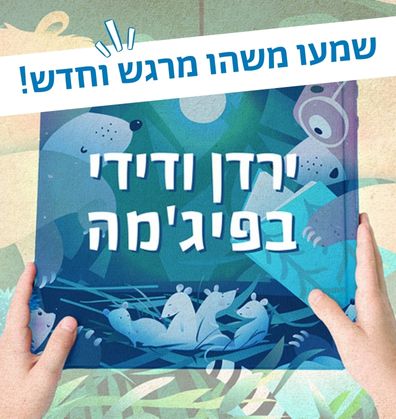כִּשּׁוּרֵי חַיִּים
פתרון בעיות
כבר מגיל צעיר אנחנו כבני אדם מתמודדים עם בעיות גדולות כקטנות. ספרים בנושא פתרון בעיות, בהם הגיבורים חווים תהליך של התפתחות והצלחה, מציגים בפני הילדים אופני התמודדות שונים ויכולים להעניק השראה וכיווני חשיבה חדשים לפתרון בעיות באופן עצמאי, או חברתי.
סְּפָרִים
Book-Related Family Activities

Family reading advice
Illustrations are an integral part of books, completing details that are not always found in the text itself. For instance, the building blocks Taylor uses only appear in the illustrations. Did you discover any other details through the illustrations? Sometimes, it’s worth trying to read a story “over again” using the illustrations and seeing what else we can discover about.

Discussion – When things fall apart
Sometimes, things we put a lot of time and effort into fall apart or fail. We can discuss that by asking – Has anything similar to what happened to Taylor ever happened to you? How did you feel? When you’re upset or frustrated – what helpscheer you up? Which of the animals in the book would you have called out to for help?

Listening exercises
Listening exercises can help us sharpen our senses and notice new things: Try speaking to one another while sitting back-to-back, and then face-to-face. How did you feel each time? Another exercise is: Close your eyes for one minute, be completely silent and still, and try only to listen to the sounds around you. When the time is up, tell the others what you heard.

Animal mimicking
What does the ostrich look like when it buries its head in the sand? What does the elephant do with its trunk when it remembers? And what does the bear look like when it is angry? Try mimicking each of the animals in the book by copying its movements, sounds and suggested solutions.
Actions Speak Louder than Words
You can discuss Yashka’s statement: “Words won’t help, we need to convince them with actions”. Ask what he means by it and what your opinion is. When is it best to speak and discuss things first, and under which circumstances would you prefer to convince with actions?
QR Code
Scan the code to watch a special video with Yossi Abolafia, the author and illustrator of this book.
For our Environment
Do you have a favorite public place in your vicinity? When you visit it, take a moment to think about what makes it pleasant, how it contributes to the environment, and how it can be protected. For example, you can initiate a cleaning up or cultivating spree with your family and friends.
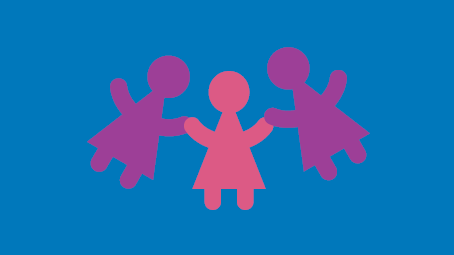
Original Inventions
Yashka makes special inventions such as a night light that turns off when you fall asleep and an underwater bird observatory. What helpful and special inventions would you like to invent? You can imagine them, draw sketches of them, or build special inventions from whatever is lying around your house.

Holes in the Boat
At home, much like the Schlofnoche’s boat, there are problems, or ‘malfunctions’ at times, that require a joint effort to solve. After reading the story, you can discuss and think together: In what situations does our family need to come up with an idea or solution? When is a joint effort needed? When do we realize there is a problem but only discuss it without trying to resolve it? And which ‘bird’ can ‘save’ us in such instances?

Family challenge
At the end of the story, in the absence of an appropriate solution, “Four Schlofnoche huddled on top of one small cabinet”.
You can also have fun finding out: How many family members can huddle together on one small carpet? Or a hammock? Or anywhere else you choose. Try coming up with creative ideas and solutions together to help with this challenge.

Creating creatures with funny names
What sort of funny name is Schlofnoche? Do you have any more ideas for similarlyfunny names? The whimsicalinos? Or sillynillies? You can come up with imaginary and amusing creatures of your own. Imagine them, draw them, color them, and then decide on a long and funny name for them.
Listen to the Schlofnoche’s Story
You can listen to the Schlofnoche’s story by watching this video.

Family reading advice
After reading, you should go back and spend time looking at the illustrations. Notice the small details that are not directly related to the text, and share your discoveries with one another.

Being considerate
At home, we also need to get along in the same “railroad car”. You can discuss and think together with your child: Which home situations require us to be considerate? Why is it important to speak up and discuss things that make us uncomfortable or that we find inconsiderate? How should we go about it?

Animals and attributes
The tortoise is slow, the owl is wise, and the rabbit is fast. You can go back to the book and check – what other animals appear in it? What are their special attributes and characteristics? Do they have the same characteristics in real life too?

Roleplay
You can dramatize this book – sit together on a “train” – parents can be the crocodile, taking up the entire railroad car, and children can be chicks. How will you go about asking the crocodile to make some room for you? Will you end up messing around and having some friendly fun together? Now, you can switch roles.
Family reading advice – From book to life
Books can help us cope with challenging situations: Toddlers identify with book characters and, as a result, learn about emotions, behaviors and challenges that exist both in books and in real life. In situations that are similar to those presented in the book, you can remind your toddlers of the book characters, and suggest that they be inspired by them and behave in a similar way: “Do you think we can maybe shift a little on the bench, and make room for our friends, just like the bears in the book did?”
מה קורה בסיפור?
You can discuss what is happening in the book with your toddlers – which problem did the bears encounter? Why didn’t the bear have anywhere to sit? What did the other bears do? You can also address the feelings that emerge from the book: How did the bear feel when he had nowhere to sit? Was he happy, sad, or perhaps surprised or confused?
Reading the illustrations
You can learn, play, and have fun using the illustrations. You can look for a different detail in them every time – can you spot the pink bear? Where’s the spotted bear? Where is the big bear and where is the little bear?
You can swap roles, and let your toddlers beckon you to search for details in the illustrations.
Like a bear
You can turn the pages of this book and pause at a different page each time to look at the bears and try to copy their movement, sitting posture, and facial expressions so that yours are exactly like the ones depicted in the illustration.
You can find more activities and special ideas on the Sifriyat Pijama for Toddlers Pinterest page.

Family reading advice
Toddlers enjoy reading books together, and when they focus on the story, they use their learning, concentration and imagination abilities. To “get into” the story and allow them to concentrate, you should disconnect from the world for a few minutes, sit somewhere calm, with no background noises, screens or mobile phones, and fly together on the story’s wings.

פעם אני החתול ופעם אני החתולה
This short book is full of experiences from toddlers’ day-to-day lives: They want to take part, sometimes they experience rejection, they strive to be independent and are busy finding solutions. You can discuss such moments in the story with your toddlers and link them to their world: What did the girl cat want? How did she feel when the boy cat didn’t want her to join him? What did she decide to do? Do you also enjoy going out for a walk? And what do you like doing all by yourself?
Let’s go for a walk!
You can suggest packing a small bag and going for a walk with your toddler, just like the girl cat, in your home or neighborhood. Together, you can think of all the things you need to take with you on your walk – a bottle of water? A hat? How about a toy?

What do the illustrations tell us?
When you look at the illustrations together, you could focus your attention on different things each time – Where is the boy cat? And where is the girl cat? What are they doing? Which items can you identify in the picture?

Family reading advice – Sharing experiences
Many books describe toddlers’ daily challenges: difficulty sharing, difficulty parting, the challenging transition from daytime to nighttime, and many more. When identifying a challenge with which your toddler is struggling, choosing a book on the subject and reading it together can be a good idea. Books invite us to share our feelings and experiences, and can offer empathy, encouragement and coping ideas.
Lea Naor was born in 1935 in Herzliya. She has written books, plays, screenplays and children’s poetry, and has also translated many books into English, such as the Dr. Seuss series. Her books and translations have won her many awards.

What is mine and what is ours?
You can discuss the things that are shared by all family members as opposed to those that belong to each of you separately. For instance: “We each have our own toothbrush – what does your toothbrush look like?”, “We all share this house together, who lives in our house?”

Dramatizing and swapping
You can dramatize this book using stuffed animals and have fun together: Swap the toys between you along with the song, and in the refrain az tekhef nihye shutafim bekhol hadvarim hayafim (“so soon we will share all the beautiful things”), you can hold the toy together, and demonstrate sharing.
Illustrations and animals
A cat, a dove, a turtle, a puppy and a young bird – all in one book! You can look at the illustrations, choose an animal together, imitate the sound it makes and act just like it according to the description found in this book. For example, if you choose the turtle “with its entire house on its back” – you can place a cushion on your back and walk on all fours. And how does the puppy with the spot wag its tail?

Family reading advice
Illustrations allow young readers to be exposed to art, and get to know new worlds that enhance the written story. At times illustrations tell another or different story than the one told in words. While reading this book, we recommend looking at the illustrations together, take a break in the reading, take another look at the illustrations, and allow the children to find special details that speak to them.

Caring and trying
Bear is trying to help his plant. He wants to take care of it. You can discuss and share – who is it that you care about? And who do you take care of? A pet? A toy? A beloved plant or perhaps a younger sibling? – How do you care for them? Have you ever tried to care for someone or something that didn’t work as planned, but things worked out in a way that you did not expect?

What illustrations tell us
What is happening to the bunnies? The amusing illustrations in this book describe an entire underground world. Together, you can look at the illustrations and tell one another what the bunnies are doing. When are they happy, sad, full or busy?

What can we see from here? And from there?
What can we see when we are sitting on the couch? And when we are standing in the center of the room? Or crawling under the table? Take turns as each family member picks a location from which to look at the room: What has caught their attention? Do they see details that others don’t see?

QR code – What can we do with a carrot?
Would you like to prepare a carrot for planting and eating? Scan the QR code to discover what can become of a small piece of carrot.
Words of emotion
The letters in the story describe feelings: missing someone, loving someone, feeling happy…
How about making some cards with words of emotion, as well as phrases that describe these emotions, and connecting each word with the sentence describing it?
Missing someone: I wish we could see each other again
Loving someone: It feels good when we’re together
Feeling happy: This tune makes me want to jump up and dance
Feeling thankful: I’m so glad we met! Thank you for coming round!
Having a party
Would you like to party like Rosalinda and Aaron? You could use the invitation they made to write an invitation of your own, prepare one of the dishes they had at their party, play some party music, and dance together.
You could even take some photos during your party, and save them in an envelope inside the book you’ve received.
Reading together
שחקו במשחק בעקבות הספר “מי זה היה מה זה יהיה”!
🖨️ מדפיסים
✂️ גוזרים
🎲 ומשחקים!

Reading together
Where is the solution to this riddle? – This book was designed in such a way, that one page asks the riddle, and the next, provides the answer to it. You may want to ask your child to guess the answer before turning the page: completing the rhyme could help. No idea what it could be? Let your child turn the page and find out.

One last illustration
Look at the last illustration together. Illustrator Ora Ayal hid the answers to all the riddles in it. Are you able to find them? Can you recall a riddle associated with one of the details in this picture? You may enjoy trying to come up with a story containing as many of the answers to the riddles as you can.

Making up riddles
Choose an item, and use each round of the game to describe one of its characteristics. For instance: “It rolls”. Your child must discover which item you had in mind. Now switch.
You could ask your grandparents, friends, and relatives the riddles in this book. Perhaps they could even ask you some riddles, and see whether you were able to solve them.

A game of "what's missing?"
We have prepared some cards for you, which you can print out and use in this game of riddles, called “what’s missing?”
Lay out 3 or 4 cards. Now ask one of the players to close their eyes, and remove one card. When the player whose eyes were shut opens them again, you can ask them a riddle to remind them which is the missing card.
Note – the number of cards you play with should depend on the child’s ability.
Reading and Discussing
You may want to tell one another some riddles you know, or share how you have found solutions to problems, situations and issues. Have you ever learned something by watching someone else? Perhaps you could ask other members of your family how they cope with riddle- and problem-solving. Together, you can create a collection of family suggestions to learn about and engage in problem-solving.
What do the illustrations tell us?
The illustrations in this book are extremely detailed. You may enjoy taking a close look at them, and telling one another what else they convey, beyond the text: Are any characters featured in them that are not described in the story itself? Perhaps you could follow the tiger character, and tell the story from its perspective: What is the relationship between the tiger and princess? Why does it follow her, and how does it experience the events that unfold?
Inspired by folktales
Authoress Ruth Calderon was inspired by an ancient folktale written by Rabbi Nachman of Breslov when she wrote this book. You could try it too! Think back to your favorite folktale or fairytale, and write a similar story about a contemporary boy or girl.
Comfort food
Do you also have a “ma’atzube” of your own – some kind of favorite comfort food? How about making a list of comfort foods, and then cooking or baking one together?
Problem-solving
“… Problems are just like bread – you need to slice them”: You may want to create a collection of everyday problems, and write them on pieces of paper. In each round, pick one note, and think of solutions together. They can be incremental, broken down into stages like slices of bread. Perhaps they can lead you to more suggestions.
Ayin Hillel (1926–1990)
Ayin Hill (Hillel Omer) was born in Kibbutz Mishmar HaEmek in 1926. An author, poet, and landscape architect, Ayin Hillel often incorporated nature, landscapes, and animals into his poems. Many generations of Israeli children were raised on his literary gems, such as the Uncle Simcha stories, Why does the Zebra Wear Pajamas?, Yossi, Smart Child of Mine, and many others. Ayin Hillel also wrote poetry and prose for adults. He won many awards for his work, and passed away in 1990.
Proposed Family Activities:
- Rabbit’s tail appears in every illustration, but Rabbit cannot find it. You may want to ask your child to leaf through the book, and locate the tail on each page.
- You could attach a kerchief to the back of your child’s pants, and go searching for their tail around the house: Where is that tail hiding? Perhaps you could follow the route described in the book: under the bed, inside the shoes, under the pillow, in the kitchen, then the bathroom, and finally sit down. Like the rabbit in the story, your child can leap for joy when their lost tail is finally found.
- Can your child name their body parts? You may enjoy playing a game in which you ask your child: Where’s your elbow? Where’s your knee? Where’s your big toe? And have them point to each body part in turn.
- Rabbit looks in the bathroom and catches his reflection in the mirror. You may also want to stand in front of the mirror with your child, name one of the emotions felt by Rabbit throughout the book, and make the corresponding facial expression: smile to show joy, make a concerned face, get excited, and so on.
- Who has a tail? Perhaps you could take out some stuffed animals or look through a picture-book to discover what other animal has a tail. Which has long ears? What other animal can leap and jump?
delicious carrot cake
- What does Rabbit like to eat? Carrots, of course! How about making a delicious carrot cake together?
Ingredients:
2 eggs
½ a cup of sugar
1/3 cup of oil
2 medium-sized carrots, grated
1 cup self-raising flour (or 1 cup of white flour mixed with a teaspoon of baking powder)
½ a teaspoon of baking soda
1 flat teaspoon of cinnamon
Method:
- Preheat the oven to 180 degrees
- Mix all the ingredients in the order in which they appear
- Put the batter in an oiled baking pan, and bake for 20-25 minutes. Insert a toothpick into the cake, and when it comes out dry, the cake is ready
- Sit in the kitchen, eat the cake together, hug each other, and enjoy
בדיוק אותו דבר – דתיה בן דור – מתוך "פרפר נחמד"
בדיוק אותו דבר – דתיה בן דור – מתוך “פרפר נחמד”
הכנת קיפוד מנייר – סרטון הוראות הכנה
A recipe for Tali's Grandma's apple pie
Ingredients
2 eggs, whisked
2 apples, peeled and diced
2 tablespoons of brown sugar
1 tablespoon of cinnamon powder
I cup of self-raising flower (or 1 cup of regular flour and a teaspoon of baking powder)
2/3 cup of white sugar
½ cup of oil
A pinch of salt
Method
Pre-heat the oven to 180 degrees.
Mix the diced apples with the cinnamon and brown sugar.
Whisk the eggs and white sugar together, and add the rest of the ingredients.
Mix the batter well.
Bake for 30-40 minutes until the pie is firm and golden.
Serve hot next to a scoop of vanilla ice cream.
Proposed Family Activities:
- You may want to look at the illustrations closely together. You could ask your child to pick a character, and tell the story from his/her perspective.
- Perhaps you could ask your child what Shira did by joining Tali under the table. You could share ideas for ways out of situations in which you feel angry, sad, or upset. You may want to share an experience in which you helped cheer someone up.
- It is not always easy to discern how others are feeling. You may enjoy standing with your child in front of the mirror, taking turns to make faces, as the other guesses which emotion those faces are designed to convey.
מה עשתה שירה
אפשר לשאול את ילדיכם מה עשתה שירה כשהיא הצטרפה לטלי מתחת לשולחן. אפשר גם לשתף זה את זה בשאלה מה עוזר לכל אחד מכם לצאת ממצבי כעס, עצב או עצבנות. תוכלו להיזכר בפעם שעזרתם למישהו ושיפרתם את מצב הרוח שלו.
לא תמיד קל לזהות את הרגשות של האחר
לא תמיד קל לזהות את הרגשות של האחר. תוכלו לעמוד עם ילדיכם מול המראה, כל אחד בתורו יעשה פרצוף מול המראה, והשני ינסה לנחש איזה רגש הוא מביע.
Leah Goldberg
Leah Goldberg (1911–1970), born in Kaunas, Lithuania, was a poetess, authoress, translator, professor, and editor, while also heading the Comparative Literature Department at the Hebrew University of Jerusalem. At the age of 23 she had completed her PhD on Semitic Linguistics in Germany, and upon immigrating to Israel in 1935, began to publish her writings, and soon became a well-loved and well-known poetess. Her publications, and among them her children’s stories and poems (Apartment to Rent [Dira Lehaskir], Magic Hat [Kova Ksamim], What do the Does do? [Ma Osot HaAyalot?], and many more) have become invaluable gems of Israeli literature. In 1970 she was awarded the Israel Prize for Literature; however, having unfortunately passed away several months prior to the ceremony, her mother received it on her behalf.
Enjoy reading and discussing the book together!
Family Activities:
- You may want to huddle together, leaf through the book, and ask your child to look for what each character received in exchange for the nuts. Pay attention to the facial expression of those receiving the nuts. Perhaps you could look in the mirror, and see what you look like when you smile with joy.
- How about looking for puppets or toys who could represent the dwarf, squirrel, lumberjacks, prince, princess, and child, and give a puppet theater rendition of the story together?
- Were you surprised by the ending? Perhaps you would like to make up your own, and illustrate it.
- The characters in this book sing when they are happy. What do you like to do when you are happy?
- Do you know any other stories or poems by Leah Goldberg? You could go over to the bookshelf at home or the local library, and look for some, such as The Scatterbrained Man from Azar’s Village (Hamefuzar miKafar Azar), Apartment to Rent (Dira Lehaskir), or The Bad Boy (HaYeled HaRa).
- The nuts in this book are magical: “whomever discovers their secret will be the happiest in the world”. You may want to share with one another what makes each of you happy. Are the same things that make you happy make your child happy too? Perhaps you can think of a family member or friend who you can surprise with something that will make them happy. How about making them some home-baked nut cookies?
Golden nut cookie recipe
Ingredients:
1.5 cups of flour
0.5 a cup of chopped nuts
150g of butter
100g of powdered sugar
1 teaspoon of vanilla extract
0.5 a teaspoon of powdered coffee
Method:
- Pre-heat your oven to 180 degrees
- Mix all the ingredients into dough and cool for an hour
- Roll the dough into nut-sized balls
- Place them on a lined baking pan and bake for 10 minutes
- Cool and store in a sealed jar
Proposed Family Activities:
- Have you noticed how the illustrator chose to depict the cat and rabbit as children in disguise? Does your child also like to play dress-up? You may want to put on some ears and tails and take a trip together.
- You may enjoy looking for the pages on which the cat and rabbit eat. What sounds do they make while eating? Try to listen to the sounds we make when we drink from a straw, have an ice-cream, or eat a crunchy apple.
- Perhaps you could act this story out using rabbit and cat puppets. You can use leftover fabrics or old socks to make your own.
- Do all of your family members like eating the same food? Which of you drink from a bottle, and which of you have hot coffee in a mug? You may want to suggest that your child try out new dishes every once in a while. Did they like them? Remember, there is no accounting for taste.
- You may enjoy inviting a new friend home, and finding an activity to do together that will make both friends happy: taking a walk, drawing, building something, or reading this book.
Proposed Family Activities:
- Perhaps you would enjoy taking a look at the illustrations together: can your child name all the shapes on every page? While reading the story, you may want to pay attention to the shapes’ facial expressions. When are they happy? And what makes them smile?
- You may enjoy using some colored paper to cut out shapes, or playing with a ready-made game of shapes. Together, you could invent other combinations of shapes, and create more things.
- Perhaps you would enjoy going on a search, and discovering the shapes that are hidden in books, toys, and various rooms of your home, such as the square floor tiles of your living room, or the round holes in your sieve.
- You may want to play with building blocks, and use the different shapes to create various artistic structures together. For although it is sometimes nice to be alone, it is so good and pleasant to play together!
- Does your child know the song Hinneh ma tov uma naim (“Behold, how good and how pleasant…”)? Perhaps you would enjoy singing it and dancing together.
- On the final page of the book, the shapes create a windmill together. Has your child ever seen a windmill? You may want to make a paper pinwheel, blow on it, and see how the rush of air moves its wings, just like a windmill.
Proposed Family Activities:
The illustrations demonstrate the clutter and noise in this house. You may enjoy looking through the book together, and finding what is misplaced and funny on each page. You could also compare the picture of the house from the beginning of the book to the one after the goat had been removed. What are the similarities and differences between the two illustrations?
Shimon’s house is not only crowded, but noisy too. You could demonstrate this to your child in the following way: turn on the TV or radio, and gradually add some of the sounds mentioned in the story. One of you could moo like a cow, another could make chicken noises, or a goat’s… until you will no longer be able to hear the TV or radio. Stop making all the animal noises at the same time, and discover just how quiet the room has become.
This story is the origin of the expression Lehotzi et Haez (“to remove the goat”), meaning to cause tremendous relief by removing something unnecessary. Is your house crowded? Does your child have any unnecessary “goats” in their schoolbag or pencil case? Try to find the reason for the clutter in your home – perhaps the drawers are full of old toys, clothes, or shoes that are no longer needed? You could tidy the house up together, and donate some of the things you no longer need. How did you feel once you removed the “goats” from your home?
Shimon and his wife go to their rabbi to seek his advice. Talking is helpful. Who do we turn to when we need advice? Who helps us solve problems? You could share some unexpected advice you may have received with your child that had proven helpful.
You may enjoy discussing a change of perspective with your child. Sometimes we cannot change reality, but are capable of changing the way we view it. Together, you could think of times when a change of attitude led you to see things differently. For it is those who are content with their lot that are truly rich.
Humor and folk tales
It’s Crowded at Home is a folk tale that takes place in a Jewish shtetl. The message of the story is conveyed humorously, with no direct preaching. The amusing tale of the goat, like many other humorous stories in Jewish tradition, remind us of that valuable life lessons are best learned with a smile!
Enjoy reading and discussing this book together!
Proposed Family Activities
- You may want to look closely at the illustrations. Were you able to find all the people and objects that went missing on their way to the nameless street? Was there anything about the illustrations that you found particularly funny?
- Does your street have a name? Do your children know it? Who or what is it named after? Sometimes streets are named after typically Israeli flowers, leaders, or historical events. You may want to research the source of your street, and adjacent streets’, names together.
- You may want to look for street signs in the illustrations. What do the street signs in your neighborhood look like? On many street signs, the name of the street appears in three languages. Can you read all the names? You could make signs for various rooms in your house, and design them in the form of street signs.
- Perhaps you would enjoy strolling around the neighborhood, and getting to know the names of the streets and their meanings. You may want to look for different things, such as: are there lampposts, benches, nice-looking trees? Is there a bus stop on your street? Where are the crosswalks? Maybe you could draw a map of the neighborhood and its streets together.
- It is very difficult to explain how to get from one place to another without using street names. Try describing how you would get from your house to school without using street names, only landmarks. You could then draw a map of the route and walk/drive according to it. Did you get lost along the way?
- We can all change things for the better – even in our own homes or neighborhood. You could hold a family discussion, or share your thoughts with your neighbors, about anything that might require improvement or repair. You could even take a vote, choose one issue to take care of, and go ahead and fix it.
- And perhaps there are some problems you cannot solve, and you would like to contact your mayor about? You could find the e-mail address for public petitions, and send an e-mail containing your request or suggestion. Maybe the mayor will pay you a visit too!
- You may want to think about how streets get their names. Think about the discussions, selection, and decisions reached. What is your opinion on the way the decision was made? Is that how all decisions are made? When is it a suitable way, and when is it not?
Family Activities
“… the tiger understood that a smile would appear on his face each time he felt happy”
Take your child for a walk outdoors and enjoy the nature that surrounds you. Like the tiger, you too can play with crushed leaves, listen to birds chirping and climb up hills.
What makes you and your child smile? You can play “the smiling game” together: Pass a ball between you. Each time one of you tosses or rolls the ball to the other, mention something that makes you happy. Don’t forget to smile throughout the game!
Where is our child and his or her smile? You can play hide-and-go-seek throughout the house, looking for each other’s smile.
The tiger looked into a puddle and discovered his smile right under his nose. In our homes we don’t have puddles but we do have mirrors! Your child can discover his or her smile in the mirror, and make funny faces at his reflection.
Song and dance are natural ways of expressing our happiness. You can sing and dance with your child, even without a special reason. Think of songs that are especially appropriate, such as “If you’re happy and you know it…”.
At the end of the story the tiger jumps with joy. If the story had continued, he might have even burst into laughter. Do you want to laugh? Here’s a funny way to start: Everyone in the family lies down on the carpet, with one person’s head resting on another’s belly. One member of the family starts to giggle, his or her tummy trembles, and soon you’ll all see how contagious the laughter becomes!
The author and illustrator Katherine Rayner loves the animals she depicts in her books. Our story is accompanied by special drawings. Go through the book with your child, noting how the tiger looks when he has lost his smile, and how he appears when he finds it in the puddle.
“Augustus and his Smile” is the first Sifriyat Pijama book of the year. Reading books together as a family is one way to bring joy and happiness into the home, and can put a smile on everyone’s faces. Enjoy!
Suggested Family Activities
- Ora Ayal has illustrated many famous Israeli children’s books. Her style is simple and easy to identify, and her books have put smiles on the faces of thousands of children around the country. You can set off on a journey through the story’s charming illustrations, and follow Tali as she turns the “yellow-and-black something” into an imaginary lion.
- Take a look at the front and back covers of the book. What is portrayed on the front, what is on the back, and how are they connected?
- You can look for the illustration of Tali and the lion swinging from a branch. Notice the expressions on their faces. Now who is afraid?
- Can you discover the faces hiding in the colored illustrations? Who are they?
- What are Tali’s daddy and the other people in the waiting room doing while Tali and the lion set off on their adventure?
- The imaginary lion transforms as Tali approaches him, takes control, and eventually befriends him. You can stand together in front of a mirror and imitate the lion’s facial expressions on each page.
- Things we fear often seem large and forceful at first. As we overcome our fear they become lighter and we sense relief. After her visit to the dentist Tali was no longer afraid, and the lion returned to his bag and once again became a “yellow-and-black something”. You can look for a colorful shawl, piece of material or blanket that can be contained inside a handbag. Your children can remove the shawl or material from the bag, don it on their shoulders and pretend they are a lion.
- What did you fear when you were young? Sharing your life experiences with your children and telling them how you overcame your fears can help them expand their “tool box” for overcoming their own fears.
- “Something Yellow and Black” is the last book distributed this year through Sifriyat Pijama. The school year is coming to an end and soon your children will set off on new experiences – whether they move to a different kindergarten or start elementary school, or join the group of older children in the same setting. We hope that this story and the ensuing family discussion will help your children in their adjustment to the new circumstances. Wishing you a wonderful vacation from Sifriyat Pijama!
Family Activities:
- The adults in the story are doubtful that the carrot will grow. You can discuss this with your children and share your own experiences. You may ask: Why do the adults had trouble believing that the carrot would grow? When you read the story, did your children think the carrot would grow? Did you ever have someone not believe you? How do you feel when others doubt things of which you are certain?
- The boy in the story does not speak, and we can only imagine what he is thinking and feeling as the others express their skepticism. If the boy could talk, how do you think he would respond? Together with your child you can select dolls to represent the boy, his parents and his brother. As you re-read the story, use the dolls to create a dialogue between the boy and his
- At the end of the story, the boy transports the carrot in a wheelbarrow. What do you think happens next? Where is he taking the carrot? How do the others respond when they see the giant carrot, and what does the boy do with it?
- The carrot grows under the ground, and not on the shelves of the grocery store! You can visit the supermarket or neighborhood grocery and take note of the various fruits and vegetables. What grows from a seed, like the carrot? What grows under the soil, and what blossoms on a tree? Which foods can be prepared from each fruit and vegetable, and what do we like in particular?
- Crockett Johnson’s illustrations depict the story that occurs above ground. You can suggest to your children that they draw a parallel story of the carrot, page after page, reflecting the process under the soil. In the end you will have two booklets illustrating the story “The Carrot Seed”: one of the boy and his family, and the other – the story of the
- There are many delicious foods that can be prepared with carrots: carrot juice, carrot soup, carrot salad, carrot bread and more! Here is an easy recipe for sweet and delicious carrot salad: Ask your children to help peel and grate a few carrots into a bowl. Add a bit of lemon juice, sugar and a handful of raisins and mix together. You can serve your carrot salad to the whole family. Bon Appetite!
- “The Carrot Seed” demonstrates the great amount of patience and perseverance needed to grow vegetables. These traits are necessary to achieve many goals in life. You can share a personal story with your child of something you achieved with great effort and after a long wait, and tell them about the sense of satisfaction this
Suggested Family Activities
- Look through the illustrations accompanying the story, and note the many things Akiva the shepherd knew before he learned to read and write. Then you can remind your children of the many things they know and can do.
- Many Jewish leaders started out as shepherds. You can discuss with your children the tasks involved in shepherding and consider the attributes that characterize a good shepherd. You might ask your child what it is in the essence of the shepherd’s work that helped Rabbi Akiva become a wise teacher and great Jewish leader.
- “One who is shy does not learn” (Avot 2,5): When Akiva saw the signs on the walls of the well and did not know how they were created, he went to the beit midrash (Jewish study hall) for answers. Where do you and your children seek answers to your questions? Are there things that your children know and you don’t? Don’t be shy – ask them!
- You can prepare a clay or Play-Do model of the well with your children. Using a knife or toothpick, you can make signs in the sides of the well – just like in the story.
- Many young children have heard of Rabbi Akiva and his wife Rachel from stories and songs. You can share other tales of Rabbi Akiva with each other and, if you know the tune, sing together “Rabbi Akiva said: Love your fellow as yourself”.
Who was Rabbi Akiva?
Rabbi Akiva, one of the most important sages in Jewish tradition, lived in the land of Israel between the years 17-137 CE. He played a role in editing the Mishna and in designing Halacha, and was the spiritual leader of the Bar-Kochva uprising against the Romans. Many stories and tales were written about Rabbi Akiva, and well-known sayings are attributed to him. One of his more famous sayings is “Rabbi Akiva said: ‘Love your fellow as yourself’: This is a great principle of the Torah” (Breishit Rabba 24,8). According to tradition, Rabbi Akiva was the son of converts and did not learn Torah until he was an adult. The story of his life, like that of other leaders and wise people in Jewish tradition, emphasizes that the Torah is accessible to everyone, even those who didn’t have the opportunity to study when they were young.
The source of the tale about Rabbi Akiva can be found in Avot D’Rabbi Natan 6,2.
Family Activities
- You may want to look through the book and enjoy the lovely illustrations. Can you spot the apple on every page? Some of the objects and animals remain constant, while others change position. Which are constant? Which are in motion?
- Have you noticed that the mouse is smiling almost throughout the book? How do you think it feels while waiting patiently?
- You may want to take puppets or stuffed animals to represent the characters in the story, and act it out to your family and friends.
- We all lose our patience at times, waiting on line at the cashier, or getting stuck in traffic. You may like to share an experience with your child in which you finally made it after having waited for something for a long time. What ‘gift’ did you get at the end of the long wait?
- Many children find it hard to wait for their parent to finish what they are doing, or for their turn to be on the computer. Perhaps you could mark the time left to wait on an analog clock. Children are often more patient when they know when their “patience time” will be over.
How about putting on your aprons and making apple confit?
Ingredients:
1 kg of green apples
1/2 kg of sugar
1 cinnamon stick
1 lemon
Peel the apples with a peeler, take out the cores and dice them. Cook the apples, sugar and cinnamon stick in a pot on a small burner for one hour (you must be patient!). Once cooked, add some squeezed lemon to your confit.
Be-teavon! Bon Appetit!
Family Activities
- Get some paper and cut outseven mouse shapes. Ask your children to color them in, using the same color scheme used for the mice in the story. After they’re done coloring, you can glue the mice to popsicle sticks and ask your children to use these figures to tell the story. Decide together how you are going to fashion the figure of the “creature.”
- We all reach mistaken conclusions at times, based on incomplete information. In order to illustrate this point, look through books, newspapers, or magazines to find a picture of something your children aren’t familiar with. You might even draw such a picture yourself. Then, using opaque paper, cover up most of the image. Are your children able to guess what the picture is just from the part that’s showing? Gradually slide the paper cover off, so that more and more of the picture is revealed. At what point do your children “solve” the puzzle and grasp what the picture depicts?
- The mice in the story guess, based on touch alone, what the new “Something” in the pond is. Together with your children, you can make a Touch Box. Take a large container and put several different objects inside. Ask your children to put one hand into the container and try to identify the objects based on touch alone. Afterwards, let them take a turn putting mystery objects into the container. Can you identify what they put in?
- Play a version of the “Blind Cow” game. Cover one child’s eyes with a bandana, twirl them gently about, and then move to another part of the room. Can they find you again using only voice cues?
- Ask your children why they think the white mouse was able to identify the creature, while the others couldn’t. Did your children notice that the white mouse didn’t come up with any new guesses of her own, instead discovering the truth through the information and guesses supplied by the other mice?
- After reading the story, you could work on a jigsaw puzzle. Choose a challenging puzzle with an age-appropriate number of pieces, and work on it together, with each one taking turns adding a piece. Is there a “method” that you use to solve jigsaw puzzles? How do we figure out which pieces go together, and at what point does the whole picture start to reveal itself?
- The white mouse describes the creature using comparisons: “Stable as a column, flexible as a snake.” You can play a comparisons game with your children, trying to describe familiar items in your home using these phrases: “sounds like…” “looks like…” and “smells like…”.
- The mice in the story cannot see; they are blind. Do you know anyone with a physical handicap? Discuss with your children the various assistive technologies and aids for people with limited vision, hearing, or mobility. Look for examples in your area, such as dedicated parking spaces for the disabled, close captioning and/or sign language on TV programs for the hard of hearing, and Braille signage in elevators for the blind. (Israel’s paper currency has been designed in such a way that those with limited vision can differentiate the various denominations by touch.)
Family Activities
- Look through the book together and examine the unusual illustrations that accompany the text. Notice the various perspectives the illustrator used in creating these pictures. Which pictures show the action from above—and which from the side? Talk with your children and ask them why they think the illustrator chose to portray the events on the bridge as she did.
- Sometimes, before we arrive at a good idea, we first have to try (and discard) some not-so-good ideas. Together with your children, go back over the various solutions which the bear and the giant proposed in the story. What are the upsides and downsides of each idea?
- Every child has experienced the clash of wills. Sometimes one family member wants to play music while the other wants quiet, or one wants to read in bed while the other wants to turn out the light and go to sleep. Or a child might be deep in a game when her parents inform her that it’s time to leave the house. … After reading the story with your children, talk about how all of us have differing desires at times, and recall any creative resolutions you and your family may have reached.
- Do you know the song, “The Whole World is One Narrow Bridge”? You can sing it with your children.
- Look around your neighborhood for a low wall, or a playground with ropes, slides, and ladders, and try (carefully!) to cross them at the same time from opposite sides. Do you, too, find yourselves forced to “dance” while hugging each other, just like in the story?
- After reading the story, you could start investigating the different kinds of bridges where you live. You could also build toy bridgesout of blocks, Legos, or other construction toys. Once your bridge is complete, you can use it to stage a little play based on the story, using dolls or Lego characters.
- Do you know other stories that feature a bridge? You can look at home, at your children’s kindergarten, or at your local library for more books and stories about bridges, including “The Bridge” by ShlomoAbass, “The Treasure” by Uri Shulevitz, and many more, and read them with your children.
Every loaf starts with a single grain
“Every loaf starts with a single grain”: You may want to ask your child how “bread is brought out of the ground”, which forces of nature helped the wheat and other ingredients grow, and what one needs in order to turn wheat into bread.
ask your child to think of five things they like to eat
You could ask your child to think of five things they like to eat. Do they know what they are made of, and how they are prepared? You may want to make a “true meal” together, one that you make on your own from start to finish, including serving and clearing the table. Did you also feel satisfied with your effort and the entire process?
The princess did not want to disappoint her father
The princess did not want to disappoint her father, but hoped she could please him without making much of an effort. She ultimately overcame the difficulties she had encountered, and completed the task well. You may want to discuss the following with your child: Why do you think the king was unhappy with the ready-made loaves of bread brought to him by the princess? What is so special about the “true” loaf of bread? Have you ever been in a situation where you achieved something that was important to you after working hard, making a tremendous effort, or repeated attempts? You may want to share this experience and subsequent feelings with your child.
King Baguette looked at his princess'
King Baguette looked at his princess’ hands to determine whether she had brought him the true loaf of bread. You could also look at your child’s hands, and try to guess what they had done today. Children’s hands resemble their parents’, but are also different. You may want to compare your hands, and notice the lines “drawn” on them. Do you have the same lines?
At the end of the story
At the end of the story, the princess learned to appreciate the farmers’ hard work, and their contribution to her life, and even learned to thank them. Together with your child, you could think of the people around you who work hard to make everyone’s lives easier. You may want to try and count all the people who have helped us throughout the day (such as the people who clean the streets, security officers, bus drivers, those in building maintenance, etc.).
playing the "thank you game
You might enjoy playing the “thank you game”. A family member starts by saying “I’d like to thank…” and tells of a good thing another has done for them. It could be anything, great or small, whether ongoing or a single incident. The next begins their sentence the same way, and ends it as they wish, and so on. You could have a thank you round at the dinner table, or before bedtime.
During the journey
During the journey, the princess makes a loaf of bread, as well as a new friend! You may want to discuss the friendship between Fire and the princess together with your child, and compare it to the princess’ relationships with other characters in the book. Perhaps you’d enjoy telling your child about your friends, and share experiences with each other.
A Ciabatta Rolls Recipe
A Ciabatta Rolls Recipe
Ingredients
4 cups of flour
40g of yeast
1 tsp of sugar
1.5 tsp of salt
1.5 cups of lukewarm water
0.25 cup of olive oil
Method
- Stir the yeast in the lukewarm water until it dissolves, add the sugar, and let the mixture rise.
- Place the flour and fermented yeast in a bowl, add the salt and olive oil, and knead into dough.
- Cover and let the dough rise for approximately two hours.
- Form rolls and place on an oven tray covered with parchment paper or corn flour (to keep them from sticking). Let them rise for another thirty minutes.
- Bake in the oven for 25 to 30 minutes, at 220 degrees.
Bon Appétit!
Family Activities
- Many things cause Isadora’s morning to be gray and gloomy. Look at the illustrations. Search through them with your children and seek out all the things that are difficult for Isadora and that annoy her. You may ask your children: “Does it ever happen to you that you get up ‘on the wrong side of the bed’? What is most difficult in this kind of morning? How do you respond when it happens?”
- Isadora isn’t alone during her day. A small goose accompanies her throughout the entire story! You may want to tell your children about the help that you receive from friends or from family members whenever you are in a bad mood, and suggest that they give thought to who accompanies and helps them to “sweeten” difficult situations.
- Isadora gathers up her gloomy morning and transforms the difficulties into a cake. You, too, can prepare a cake, and sweeten it even more by adding chocolate sprinkles, raisins or candies. You may want to relate to all the sweet additions as symbols of difficult things in the children’s lives, thereby demonstrating the expression “Me’az yatza matok” (Out of the strong came sweetness).
- Isadora is very active. She dances, plucks, bakes, and in the end eats the entire cake! You and your children are invited to make a list of ten ways to overcome a bad mood. You can prepare an illustrated list together and to hang it in a convenient place, as a reminder whenever the need arises.
- Little by little the illustrations in the story change from black to gray to pink. You might explain to the children the special symbolism of various colors. For example, the color pink symbolizes happiness and being positive. It would be fun to prepare some “rose-colored glasses” together from construction paper and rose-colored cellophane. Put them on and see how everything looks different!
- What do you think: Do you and your children think that eating the entire cake was a good idea?
- You and your children may want to invent a different ending for the story. Send your ideas to the Sifriyat Pijama website pj.crunchcart.com, and we’ll post them on the site!
Activities to Do Together at Home
Where do you do your grocery shopping? At the corner store? The supermarket? Perhaps the farmers’ market (shuk)? Together with your children, you could find a cake recipe, make a list of all the necessary ingredients, and go shopping together. Then, when you come back home, bake the cake together and share it with your friends and family!
“Ding-ding when you enter, ding-ding when you leave.” You could make some bells for your door. Fasten some small bells, beads, shells, or even some old spoons or keys together. Hang them on the wall or suspend them from the ceiling right by the open door, and wait for the breeze to make your bells go “ding-ding.”
Mr. Gedalyahu dreams a strange but entertaining dream, mixing the real with the imaginary. Have a conversation about dreams with your children. See if they can recall a dream they dreamed. Talk about how sometimes you might feel unsure whether you’re asleep or awake, and about things that can happen in a dream but not in real life. Give free rein to your imagination—draw pictures of your dreams!
Explain to your children the meaning of the Psalm verse, “I have learned something from all my teachers,” and see if you can recall the wise sayings attributed to the cricket. You could choose one of the cricket’s sayings and draw a picture of it. Do you know any other wise sayings? Every creature can serve as a source of wisdom for us. You could ask your children from whom (or what) they have learned something.
In his dream, Mr. Gedalyahu sells unnecessary things to a hen, a goat, and a bee. Talk about buying things. Do you always buy only what you need? Or are you sometimes tempted to buy something you don’t really need? After reading the story, talk with your children about how to be a wise consumer and about the difference between something you need and something you perhaps want but don’t need – always remembering that dreams, too, hold an important place in our lives.
Haya Shenhav
Haya Shenhav is a poet and author born in 1936 in Kefar Yehoshua, in the Jezreel Valley. Her first children’s book, Mitz Petel (“Raspberry Juice”), was published in 1970, and is a huge favorite among children to this day. Among her well-known and much loved works are Aliza Habarvaza Vehahaverim (“Aliza the Duck and Friends”), and Hippo-Tam, as well as the songs Gveret Im Salim (“A Lady with Groceries”), and Mi Shavar Et Hatzalahat (“Who Broke the Plate?”). In 1985, Haya Shenhav was awarded the Zeev Prize for Children and Youth’s Literature, and in 2004 she was the Bialik Literature Prize laureate. Haya Shenhav lives in Ein Kerem, Jerusalem.
Family Activities
Pit, Pet, Tu is a long and adventure-filled story. You may want to read one adventure at a time, and then ask your child to pick an illustration, and tell you what the dwarves are doing now in their own words.
You could read it together several times, helping your child remember the sequence of events, and join you for the refrain: “Dwarves can do such things…”
You may enjoy looking at the illustration depicting the dwarves turning the mountain into a home. Do you recognize the food? What is your favorite? You may want to prepare one of the dishes the dwarves ate, or plan a back-to-front meal, where you eat dessert first.
One of the dwarves’ favorite pastimes is chatting. They enjoy sitting with one another, and remembering shared experiences. What do you like doing with your friends?
Do you know the tune to the song Meahorey Hahar 1, 2, 3 (“Behind the mountain, 1, 2, 3”)? You could sing it together.
Each time the dwarves transform the mountain into something else – a home, a boat, and even a car. You may also want to engage in a game of “pretend”, and turn familiar objects into other things using your imagination. You could pick a different object each time, and tell each other what it has turned into.
Would you like to play with dwarves? You may enjoy drawing little dwarves on toilet paper rolls, popsicle sticks, old socks, or rolled-up paper… You could make three dwarf puppets, and use them to tell the story.
Pit, Pet, Tu is the last PJ Library book you will be getting this year. Enjoy reading it, and also reread your favorite PJ Library books from previous months. Perhaps this time you could let your child read it to you… See you next year!
Family Activities
- You may want to read this story several times, pointing out the various animals, the feather, dog leash, and nut. As you read it a second and third time, your child will be able to point at the illustrations instead of you, and know the name of each item depicted.
- You may want to pay attention to the details drawn by author and illustrator Kevin Henkes. Did you notice that the dog, squirrel, fox and bird are all part of the little girl’s good day at the end of the book?
- You may enjoy looking for the picture in which the bird looks for its lost feather. Can your child reveal the feather’s hiding-place?
- You may want to use puppets or stuffed animals and act the story out.
- Perhaps you would enjoy looking at the final illustration and guess how the little girl’s day had begun. Did she also get off to the wrong start?
- At the end of the story, the little girl finds a feather. You could buy synthetic feathers and glue in an arts & crafts store with which to decorate your own colorful bird.
- You may enjoy taking a yellow feather, much like the one the little girl found in the story, curling up with your child and tickling them with it.
You may want to read the story several times
You may want to read the story several times, enjoying together the rhyming games and opposites, and accompanying Miriam on her quest for the sea. After several readings, your child will probably be able to complete the sentences, and “read” the story themselves.
Does your child know the sea?
If you do not have a beach close by, you could spend some time at the pool, fill a tub in the back yard, or even have a bath. Take simple seaside playthings along with you, such as a funnel, sieve, and various sized plastic bottles. Have fun!
Miriam's questions contain many opposites
hot–cold, big–small, old–new etc. You may enjoy playing an opposites game together. One of you could ask the other: “Is it ______ (hot, big, old…)?” and the other could reply: “No, it’s ________ (cold, small, new..)!”
You may enjoy playing the "warm-cold" game together
One of you thinks of an object in the room, and leads the other toward it using clues of “warmer” (the object is close by) or “colder’ (the object is far away).
Following the story, you may like to have a conversation with your child about seasons,
Following the story, you may like to have a conversation with your child about seasons, and discuss how our activities change in winter when it is raining outside, and in summer, when it’s hot out.
Mirik Snir wrote dozens of wonderful books for young children
Mirik Snir wrote dozens of wonderful books for young children. You may want to look for them, at home or the library, and read them together

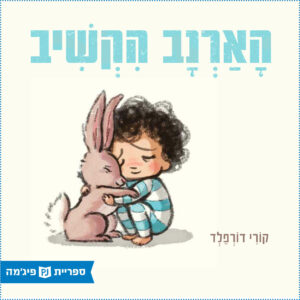 The Rabbit Listened
The Rabbit Listened 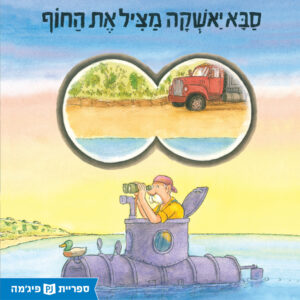 Saba Yashka Saves the Beach
Saba Yashka Saves the Beach 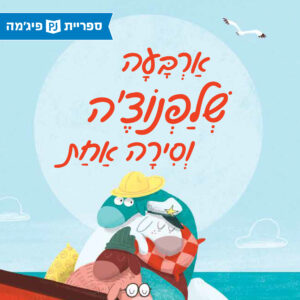 Four Shlofnoche in a Boat
Four Shlofnoche in a Boat 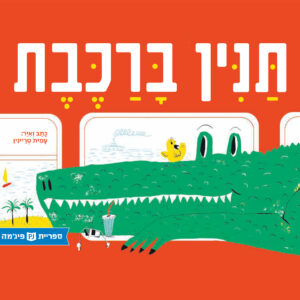 A Crocodile Gets on a Train
A Crocodile Gets on a Train 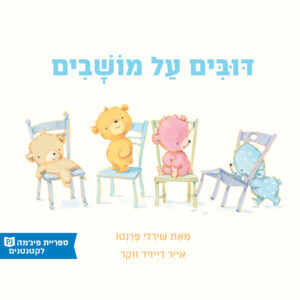 Bears on Chairs
Bears on Chairs 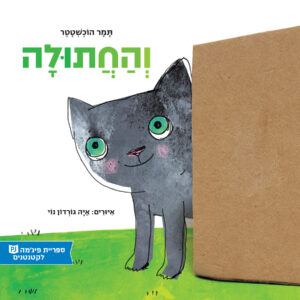 And the Cat
And the Cat 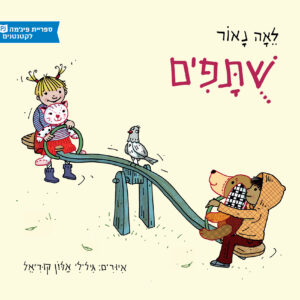 Partners
Partners 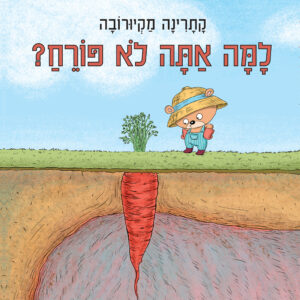 Why Don’t You Flower?
Why Don’t You Flower? 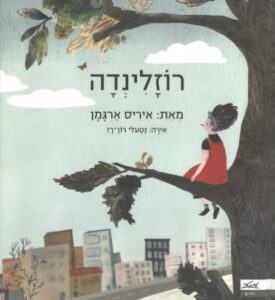 Rosalinda
Rosalinda 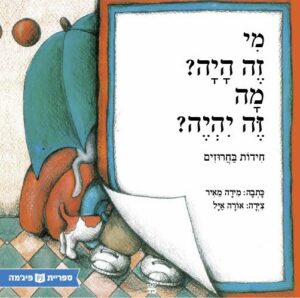 What’s That? What Could it be?
What’s That? What Could it be? 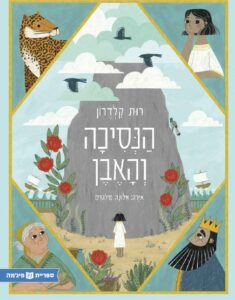 The Princess and the Rock
The Princess and the Rock 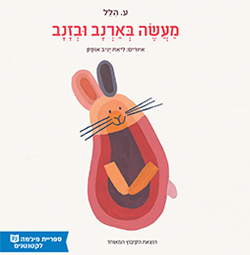 A Tale of a Rabbit and a Tail
A Tale of a Rabbit and a Tail 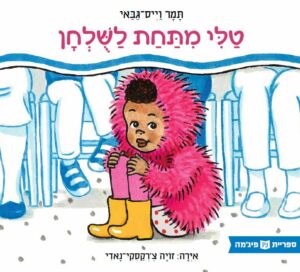 Tali is under the Table
Tali is under the Table 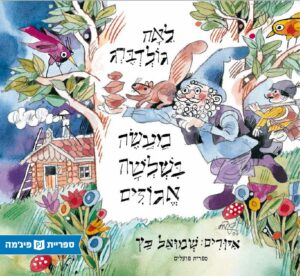 A Tale of Three Nuts
A Tale of Three Nuts  A Rabbit and a Cat are going on a Trip
A Rabbit and a Cat are going on a Trip 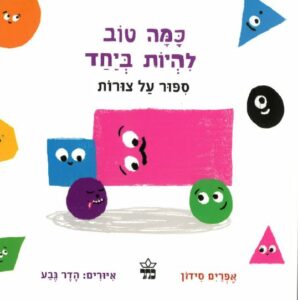 Friendly Shapes
Friendly Shapes 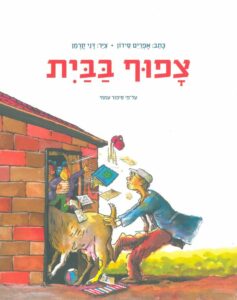 It’s Crowded at Home
It’s Crowded at Home 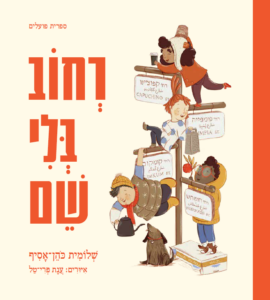 A Street with no Name
A Street with no Name 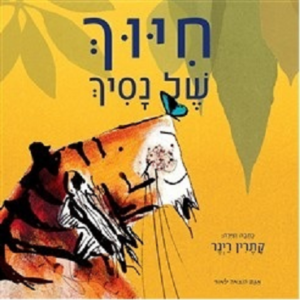 Augustus and his Smile (Hebrew title: Prince’s Smile)
Augustus and his Smile (Hebrew title: Prince’s Smile) 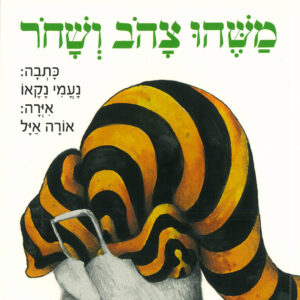 Something Yellow and Black
Something Yellow and Black 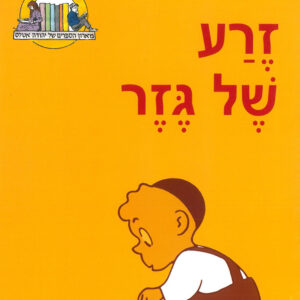 The Carrot Seed
The Carrot Seed 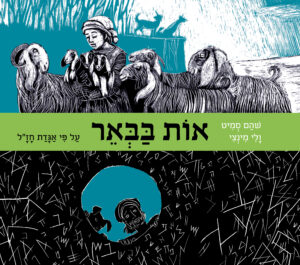 Signs in the Well – Based on a Talmudic tale
Signs in the Well – Based on a Talmudic tale 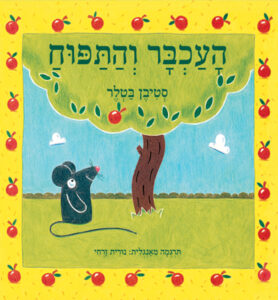 The Mouse and the Apple
The Mouse and the Apple 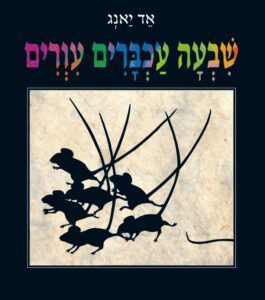 Seven Blind Mice
Seven Blind Mice 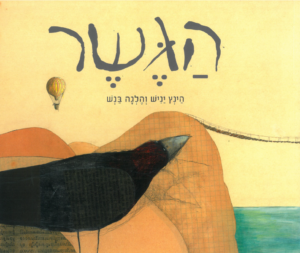 The Bridge
The Bridge 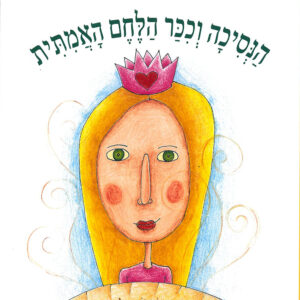 The Princess and the True Loaf of Bread
The Princess and the True Loaf of Bread 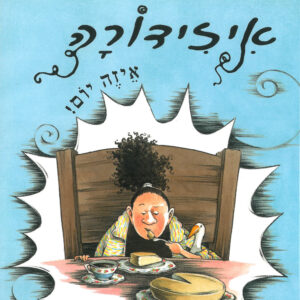 Mrs. Biddlebox In Hebrew, “Isadora, What a Day”
Mrs. Biddlebox In Hebrew, “Isadora, What a Day” 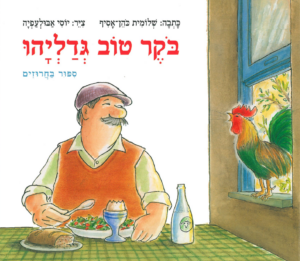 Good Morning, MrGedalyahu
Good Morning, MrGedalyahu 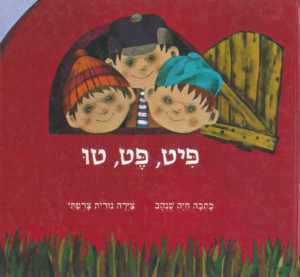 Pit, Pet, Tu (“Chit, Chat, Chatter”)
Pit, Pet, Tu (“Chit, Chat, Chatter”) 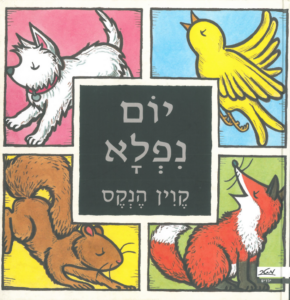 A Good Day
A Good Day 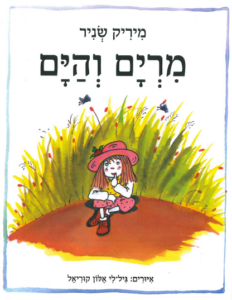 Miriam and the Sea
Miriam and the Sea 






